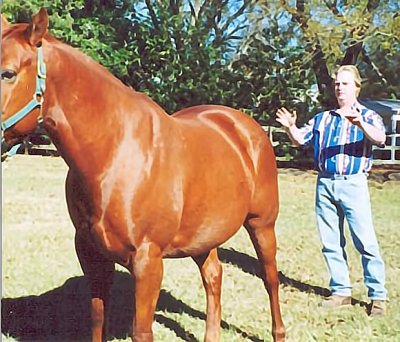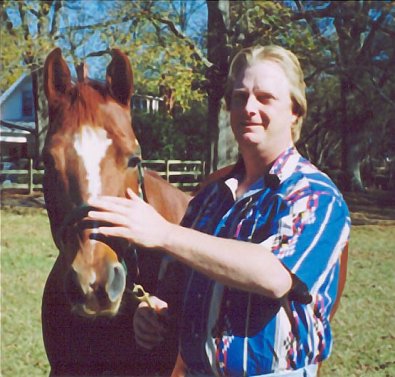I had the pleasure of meeting Mike Stine on my last trip to New Zealand. He was there visiting a good friend of mine Ray Morris. Ray, saddler and horse masseur and Mike had become great friends after meeting at Equitana USA in 2000 where both had been speakers.
Mike Stine is a farrier, but not your typical farrier.
When Mike comes to to shoe your horse he takes an holistic approach He analyzes your horse's walk and trot in-hand, much like a lameness exam from a vet. Why? Over the past 20 years, Mike has developed a movement-related approach to shoeing. "Horses will tell you what they need if you pay attention to the relationships between skeletal, muscular and movement patterns, and joint alignment. Movement gives you much more information than just looking at the lower leg and hoof."

Mike Examining Lady
Mike credits his mentors Tony Gonzales and Clyde Caldwell for teaching him to look at the whole picture, including rider position and tack fit, and use that information in making decisions on how to shoe. He blends the natural-balance shoeing theories developed from Gene Ovnicek's years of mustang research with his own field studies to work toward a balanced body in each horse.
For years, Mike has presented clinics and demonstrations at Equitana, Carolina Classic Horse Expo, CDI International, and Southern Horse Festival. He recently conducted clinics and private consultations in Australia and New Zealand. Mike has also been a radio guest on Rick Lamb's nationally syndicated "The Horse Show and appeared on national and cable television shows.
In addition to being a Registered Journeyman Farrier and educator, Mike is also a member of the Board of Directors for the Guild of Professional Farriers, a BWFA Journeyman Farrier and Tester. Other certifications include Proper Balance Movement in the field of equine biomechanics and Equine Podiatry from the Equine Podiatry Center in Kentucky, under Dr. Rick Redden. He has attended numerous Laminitis Symposiums and Natural Balance Shoeing clinics.
Mike receives referrals from Gene Ovnicek, the developer of the Equine Digit Support System. He's also worked with Dr. Richard Mansmann of NC State University on horses needing comprehensive gait analysis.
Mike Stine's affiliations include:
SHOE (Southeastern Horseshoers on Education) Board of Directors, SHOE President for 4 years, REINS (Regional Equine Information Network) Region II Board of Directors, BWFA (Brotherhood of Working Farriers Association) and former AFA (American Farrier's Association) Board of Directors.
Mikes website Equine Dynamics - http://www.equinedynamics.com/index.htm - stress that
"Equine Dynamics is the flow of movement in the horse without strain or interference. In the broadest sense everything in a horse's life affects his ability to move and perform. Helping a horse work through performance and soundness issues has been my driving passion for many years. Those issues can often be addressed through proper hoof care, an individualized exercise program, and a careful examination of tack and rider. Teaching horse owners to understand the dynamics of their horse empowers them to recognize and prevent problems before they occur."
I was interested in discovering what had lead Mike to become the farrier he is today. This is his story.
The Horse That Changed My Perspective
As a teenager not sure of my place in the world and pretty much a loner, I purchased my first horse, a stocky little buckskin mare around 14.2 hands. With no formal riding lessons, this athletic quarter horse type barrel racer quickly taught me to have a good seat (or eat dirt)! We competed in gymkhana events such as barrel racing and pole bending, but my favorite times were riding in the woods, up and down hills for hours on end, just me and the buckskin mare.
When it came to caring for a horse and their feet, my main concern was how much it cost and how long the shoes stayed on before I had to come up with more money. Working as barn help during high school, the budget was always tight. However, I was always intrigued by horseshoeing and attended a technical college trim/horseshoeing course in my twenties. By this time I had married and had three horses whose feet I had started to care for myself. Gradually through word of mouth I took on more horses and it became a part time business in addition to my full time job as a lineman.
The summer of 1988 would change my life. My beloved buckskin mare somehow contracted a respiratory virus, which despite our and the veterinarian's best efforts, turned into pneumonia. The vet had tried everything within his power with no success and suggested that we take her to the nearest veterinary college, two states away. Without our own horse trailer at the time, we relied on the generosity of friends who let us borrow their truck and trailer. After checking on her each time we stopped on the several hour drive, imagine our horror when we arrived at the vet school, opened the trailer door to find a floor board had given way in the trailer floor. With scrapes on her hind legs, the terrified mare stood frozen, straddling the open gap in the floor. (Lesson 1 - Always inspect trailer flooring!) Somehow she had managed to get footing on solid boards, but the trauma together with the pneumonia produced laminitis...now this hardy little mare was battling two major illnesses.
After a few weeks at the vet school, the pneumonia was stabilized, but the laminitis would be a battle for three months. Back home, we spent a few hours each day before work and more after work doctoring the brave mare who had so much heart to endure numerous veterinary and farrier visits. Everyone did the best their training allowed, and we cared for her the best way we could. Eventually, not wanting her to suffer further and with a grim prognosis, we made the most difficult decision to humanely euthanize my beloved mare. Ironically, the very same day, the great Secretariat was also euthanized due to laminitis. Anything about Secretariat always reminds me of the work to be done to give our horses better lives, as I wish could have been done for my best friend.
The experience of feeling helpless to change that outcome, sent me on a quest for more information, especially as it related to farrier science. My eyes had been opened about how uneducated I was about caring for horses hooves, both from a preventative standpoint and in a crisis situation. (Lesson 2 - Continually educate yourself as a horse owner.) Attending every clinic, symposium or convention I could find, I soaked up information on types of shoes, trimming methods, tools, philosophies- whatever was available. One weekend in Georgia I attended a clinic that forever changed my perspective on hoof care, from looking at just the horses' lower leg and hoof to looking at the entire horse.
Realizing there's a lot more to look at than just the hoof opened up a whole new world of horseshoeing. By now, my business had grown into a full time farrier service and I wanted to be knowledgeable and skillful, able to do my best to prevent other horses and horse owners from having a painful experience like ours. Little by little, I studied how different methods of trimming or shoeing affected the entire horse and his performance. Often between shoeings, I would ask the owner for permission to look at a horse to confirm whether my theory was correct. I studied how the horse's body changed as a result of a trim or shoeing method. It became evident to me that horses, like people, are individuals and not every method works the same with every horse. But it also became evident that there were patterns that almost always hold true, and were often opposite of what you would expect. Having a different approach to farriery in a field that often relies on the way things "have always been done" has not been easy, but it has paid off in results. When horse owners had confidence in my theories and gave permission to try different approaches, the success has shown in the horses' improvement. Not that everything is fail proof - sometimes the same problem has required different solutions on each horse. Usually the patterns would emerge that gave clues to how a horse would move, the problems likely to develop with that horse and how best to help prevent those problems. The opportunity to figure out why one horse's movement problem didn't respond as expected and finding a different solution has had me waking up in the middle of the night with an idea on how to help that horse with a certain shoe or trim. It is exciting and rewarding to do a job and know it helps that horse live a better life.
Over the years I've been fortunate to work with many special horses who had unique problems, and they have been my best teachers. I'm also in debt to the master farriers along the way who were willing to teach and ask thought-provoking questions. Only by carefully watching and putting together correlations between cause and effect am I able to hear what these horses are teaching me. Many things have been learned the hard way through mistakes made as a horseman and a farrier, and my hope is that I can pass some of these lessons to horse owners. As horse enthusiasts, I feel it is our job to be as educated as we can be in order to care for the equines entrusted to our care. As a farrier, I strive to work with the entire horse to allow them to live a long comfortable life and reach their full potential in whatever activity we choose to participate. All because of a little buckskin mare that changed my perspective in more ways than one.

Mike and Lady
Mike Stine
Registered Journeyman Farrier
www.equinedynamics.com
Mike is looking to come to Australia in the not so distant future, so if you are interested in finding out more about his services visit his website.